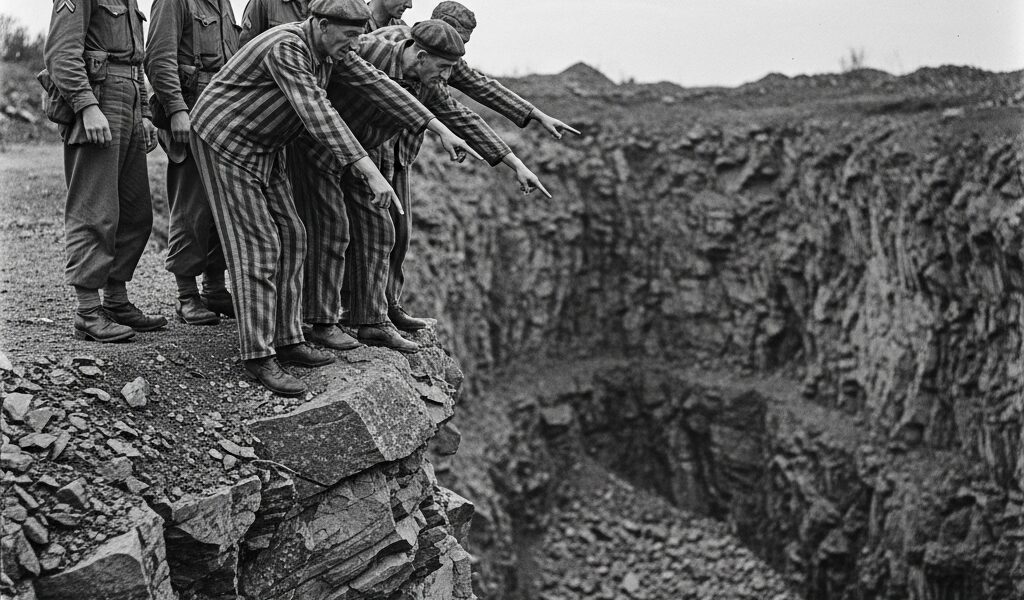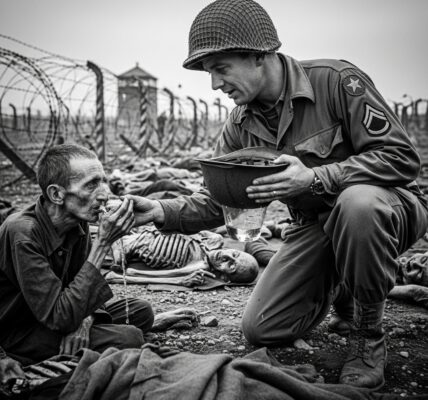The Career of Silence – Testimony from Mauthausen
In May 1945, as the Western Front of World War II drew to a close, American troops entered the Mauthausen concentration camp . With them came the moment so long awaited by thousands of prisoners: liberation. But freedom, however much desired, was not accompanied by a cry of joy. It came in silence, laden with an unimaginable weight of memories, pain, and lost humanity.
The survivors who had endured the hell of the Mauthausen concentration camp were speechless. When the American soldiers entered the camp, prisoners in striped uniforms led them to the edge of the quarry, a place of suffering and a symbol of exploitation. There, on the edge of the cliff, they stood together, liberated and liberators, gazing at the stone quarry where thousands of lives had perished.
Some prisoners raised their hands, pointing toward the chasm. This was where their daily nightmare unfolded. This was where the SS pushed people to the ground, treating human life like worthless stone. This was where prisoners carried heavy boulders up steep staircases until their legs gave way and their bodies collapsed, falling one by one like anonymous victims of violence. The Mauthausen quarry— the Wiener Graben —became a place where humanity was systematically crushed.
The American soldiers remained silent. None of them were prepared for such a sight. They had seen destroyed cities and fallen soldiers before, but never had they encountered such a profound dimension of evil, disguised as everyday life. As the survivors spoke of hunger, beatings, and death, words seemed inadequate. So, instead of speaking, they let the landscape speak for itself—an abyss of stone and silence.
This image—a group of prisoners in striped uniforms alongside soldiers bearing the inscription “US Army” on their helmets—has become one of the most symbolic testimonies of the Holocaust . In an instant, it connected two worlds: those who had endured hell and those who had come to end it. For the prisoners of Mauthausen, freedom meant more than simply the end of captivity. It was an opportunity to reveal the truth, so that those who saw could believe.
The Mauthausen quarry had 186 steps—too narrow, too steep, too dangerous. Prisoners were forced to carry stones weighing several dozen kilograms up them, often under the blows of the SS guards. One wrong step meant death. Sometimes, to add to the spectacle, the guards ordered the prisoners to run with stones on their backs. If someone stumbled, they fell, their body pulling the others down with them—creating an avalanche of human suffering. This place was nicknamed “the Staircase of Death.”
Hundreds of thousands of stories are written in these stones – anonymous, silent, but true. Mauthausen was one of the harshest camps of the Third Reich. It was here that those whom Nazi ideology considered “useless” were imprisoned: intellectuals, political opponents, Jews, Poles, Slovenes, French, Spaniards, Russians. For many, this place became the end of the line of the Holocaust, the final stop on the map .
For the survivors, returning to the quarry after liberation was like returning to an open wound. But it was also an act of courage. By pointing to the abyss, they not only told the soldiers what had happened there, but they also testified that the memory would endure. Their silence was more powerful than any words.
The photograph taken that day became iconic. It shows people in striped uniforms, their faces gaunt but their eyes shining with life. Beside them stand American soldiers – young, in steel helmets, but unaware that they had witnessed one of the greatest crimes in history.
Looking at this painting today, we see more than just a group of people on the edge of a cliff. We see the meeting of two worlds: the world of suffering and the world of hope. We see proof that the truth, sometimes hidden beneath layers of stone and silence, always eventually emerges.
For the survivors of Mauthausen , freedom meant far more than breathing clean air. It meant being able to tell their story—a true and painful story, but one essential for the world to understand the consequences of hatred. Many returned to their home countries after the war, trying to rebuild their lives. But the memory of the quarry, its smell, the echo of footsteps on the death steps, haunted them forever.
At Mauthausen, every stone had its price. Some prisoners said that even the earth there was heavier, steeped in suffering. In the spring of 1945, the melting snow revealed bodies and bones. For the American soldiers, this sight was devastating. For the survivors, it confirmed that evil, even briefly triumphant, could not break them.
The story of Mauthausen is not just a story of crime. It is also a story of survival and dignity. In a world that sought to dehumanize them, the prisoners found within themselves a spark of strength to help others, to share a piece of bread, to believe that justice still existed somewhere.
Freedom arrived in May, a month that always smells of new life in Europe. But at Mauthausen, that scent mingled with the smell of ashes. Survivors emerged from behind the barbed wire, uncertain of their true freedom. Their bodies were ravaged, but their spirits were unshakeable. Standing at the edge of the quarry, their gazes downcast, many felt as if they were contemplating a past that would never be repeated.
This photograph, taken by American soldiers , has become one of the most important documents in the history of World War II . It captures the moment when truth meets freedom, when silence becomes testimony. Today, it is part of our collective memory, reminding us that behind every historical event are human beings: those who suffered and those who witnessed.
In an age where the line between truth and falsehood can blur, the image of Mauthausen possesses a unique power. It is not merely a snapshot of the past. It is a warning. The quarry where so many perished is now a silent monument, more eloquent than a thousand books. Anyone who pauses there hears the echo of the footsteps of those who never left.
The story of the Holocaust is not simply a matter of numbers and dates. It is an unheard cry, drowned out by time. But thanks to the testimonies of survivors, like those who showed the quarry to American soldiers, this cry still resonates – in museums, in books, in collective memory.
Today, more than seventy years later, Mauthausen remains a place of pilgrimage. People come to pay homage to the victims, to bear witness to the true horrors, but also to grasp the true meaning of hope. For though the stones are silent, their silence is laden with meaning.
The freedom won at Mauthausen was not just a military victory. It was a victory of humanity over hatred. Those who stood at the edge of the quarry knew they would never forget. A promise was written in their eyes: that the world would know the truth.
And the world did it. Mauthausen became a symbol, and his story a testament that even in the darkest places, history can find light. In this abyss, where men perished, their courage still resonates today. An echo that reminds us that freedom is not a gift, but a responsibility.
Note: Some content was generated using AI tools (ChatGPT) and edited by the author for creative reasons and suitability for historical illustration purposes.





